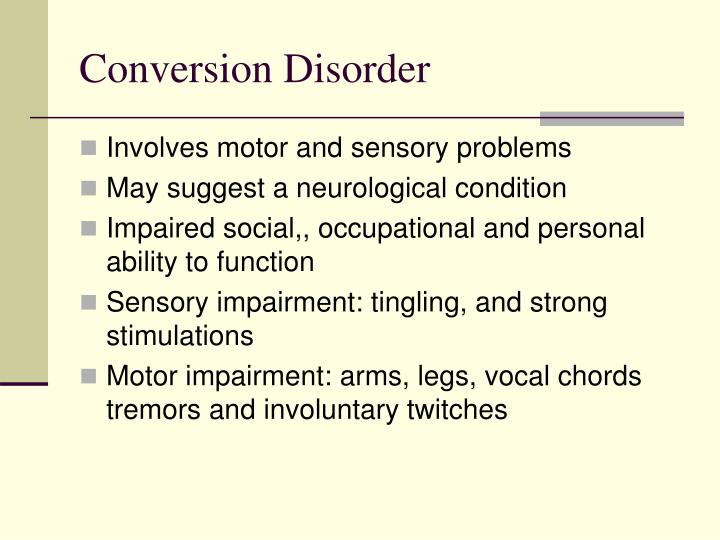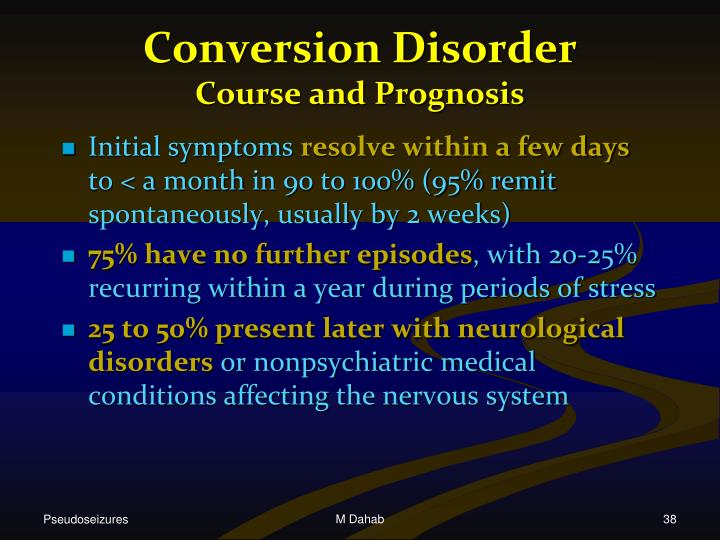Simple Info About How To Treat Conversion Disorder

A physical therapist may recommend a range of exercises including stretching, biofeedback, gait and locomotion training,.
How to treat conversion disorder. Psychiatrists use psychosocial models for conversion disorder and see an overlap with feigning. The clinician may want to empathize and focus on caring rather than curing, as the individual may want to feel understood and not dismissed. Treatment for patients with a functional neurological disorder (conversion disorder):
How is conversion disorder treated, and is there a cure? Overview symptoms diagnosis treatment complications outlook conversion disorder is when a person experiences temporary physical symptoms, such as blindness or paralysis, that do not have a. Treatment of conversion disorder begins by establishing a trusting relationship between the individual and clinician.
Functional neurological symptom disorder (conversion disorder) is characterized by neurologic symptoms such as weakness, abnormal movements, or nonepileptic seizures, which involve abnormal nervous system functioning rather than structural disease [ 1 ]. Last reviewed on january 08, 2024. Conversion disorder is usually seen in women and younger aged people, but rare before age 10 and often clinical based [ 3 ].
Treatment coping conversion disorder (also known as functional neurological symptom disorder) is a psychological condition that causes symptoms that appear to be neurological, such as paralysis, speech impairment, or tremors, but with no obvious or known organic causes. Or others may be appropriate. These signs and symptoms are inconsistent with patterns of known neurologic diseases or other medical conditions.
Introduction conversion disorder, also known as functional neurological symptom disorder (fnd), is a psychiatric disorder characterized by symptoms affecting sensory or motor function. 2 psychological factors, such as conflicts or stress, are judged to be associated with the d. Conversion disorder is a condition in which you have physical symptoms but no injury or illness to explain them.
For instance, imagine that you were in a. Conversion disorder may also be treated through the use of psychotropic medications that address underlying psychiatric problems, such as depression and anxiety. Psychiatrist or other mental health professional;
A prevalence in western countries has increased over recent years. 7 min read what is conversion disorder? Conversion disorder is a complex and controversial condition that involves neurological symptoms without an organic cause.
Learn about the signs and symptoms of conversion disorder and how it’s diagnosed and treated at chop. This article reviews the recent advances in our understanding of its diagnosis, etiology, pathophysiology, and treatment, based on neuroimaging, genetic, and psychosocial studies. Introduction conversion disorder, formerly known as hysteria, can be defined as one or more symptoms of altered voluntary motor or sensory functions that cannot be explained by a neurological disease [ 1, 2 ].
Conversion disorder, functional neurological disorder, neuropsychiatrist, attitudes,. Functional neurologic disorder (fnd), also known as conversion disorder and functional neurologic symptom disorder, refers to a group of common neurological movement disorders caused by an abnormality in. O’neal , m.d., gaston baslet , m.d.
5 as regards the prevalence of conversion disorder: For some people, a multispecialty team approach that includes a neurologist; They believe psychiatrists are essential for the diagnostic process and would not usually support a diagnosis without a psychiatric formulation.


















